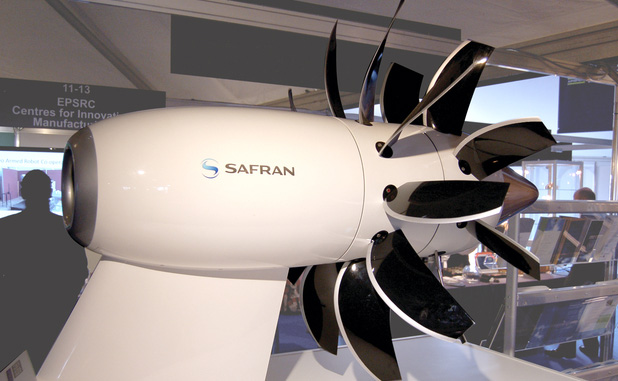Helen Knight reports

A new aircraft engine design that could cut greenhouse gas emissions from air travel is a step closer to reality, thanks to the development of advanced bearings.
The new engine design, known as Open Rotor, is being developed as part of the EU’s huge Clean Sky research programme, in a project called Sustainable and Green Engine (SAGE) demonstrator SAGE2.
Open-rotor aircraft engines generate most of their thrust from two counter-rotating propellers, rather than the ducted fan that drives conventional turbofan engines.
This means the engine diameter can be larger, improving its efficiency, without creating the need for an excessively big and heavy engine nacelle.
The concept was first investigated in the 1980s, following the oil crisis where the price of fuel sky-rocketed. But as the oil price dropped again, interest in the idea waned. Now the concept is being revived, in a bid to reduce fuel consumption and carbon dioxide emissions from air travel.
With two propellers spinning in open air, the engine design can, in theory, significantly increase air flow and thrust, thereby reducing both fuel consumption and emissions.
But in order to make the design a reality, advanced bearings are needed to manage the loads produced, and to control the angle of the propeller blades. To this end, a technology development call was issued under the Clean Sky programme, which was answered by bearings manufacturer NTN-SNR, based in Annecy, France.
As a result, the SNRPBBEARING project was established in 2013, to investigate different bearing designs, and to develop whichever concept offered the greatest potential to withstand the large loads and high temperatures the devices would be subject to.
The SAGE2 demonstrator consists of two propeller modules, one fitted with 12 blades, and the other with 10 blades, according to Guillaume Lefort, aeronautical product design engineer at NTN-SNR.
“It’s a new design of engine, with two big propellers at the rear of the engine, and the bypass ratio between the low pressure airflow and high pressure airflow is higher (than a conventional turboprop engine),” he said.
In aircraft engines, the bypass ratio refers to the ratio between the mass of air passing around the engine core, and the mass of air passing through it. Engines with higher bypass ratios typically consume less fuel.
Each of the propeller blades within the two modules are attached to polygonal rings, and set at different angles by devices known as pitch control mechanisms.
The role of the bearings is to ensure that any aerodynamic or centrifugal loads on the blades are transferred to the polygonal rings, while also allowing the blades to change pitch as needed.
“All the blades on each propeller have to face the same direction, so in order to move the blades it is necessary to have bearings on each blade root,” said Lefort.
“These blade roots are similar to those on conventional turboprop engines, but the rotation speed is higher, so you also have some physical loads that are higher, and the temperatures are also higher,” he added.
“Current designs, and in particular bearing lubricant and sealing, are not compliant with these new specifications,” said Lefort.
Indeed, the blades on open-rotor engines can be subject to temperatures ranging from –55˚C to 180˚C.
To design the components, NTN-SNR performed finite element calculations to determine the impact of the stiffness of the polygonal rings and blade root on the bearings themselves. The company then had to develop a complex tribological system inside the bearings, in order to minimise friction.
Extensive work was also carried out to design complex sealing devices, in order to avoid lubricant leaking outside of the bearing, and to prevent pollution from the environment getting into the bearing.
The bearings then underwent a successful preliminary design review, after which the project team made some improvements to the components based on comments from manufacturers.
By the end of last year, the project had developed and manufactured 26 bearings up to technology readiness level five. This means the prototypes had been thoroughly tested.
“Once the bearings had been manufactured, we tested one of them under representative conditions, to validate the product before delivery to the customer,” said Lefort.
The manufactured bearings have now been delivered to the engine maker, who will assemble them onto the SAGE2 demonstrator.
The completed SAGE2 engine demonstrator is due to undergo a set of ground tests at Istres in
southern France, by the end of this year.




Swiss geoengineering start-up targets methane removal
Several rather dubious statistics in this report. IF methane had 120× the thermal effect of CO2 that would be TWO orders of magnitude. Two is not...